|
A central air-conditioning system circulates cool air throughout the house with a network of ducts. Typically, these same ducts are used for heat distribution in winter. When the thermostat calls for cooling, the outdoor compressor switches on and circulates refrigerant through both coils. The furnace blower forces indoor air through the evaporator coil, where it's cooled, dehumidified, and then circulated throughout the house. Heat taken from the indoor air stream is transferred to the condenser coil and then to the outdoor air. |
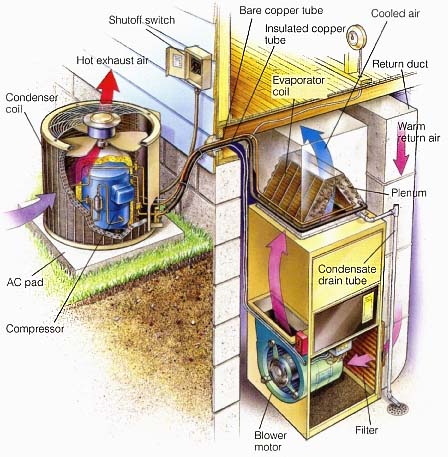 Above: How a central air conditioner works: The two main parts of a central air system are the outdoor compressor with a condenser coil and an indoor evaporator coil that’s located in the plenum above the furnace blower. Two copper tubes, one bare and one insulated, connect the two coils and transfer refrigerant between them. If you have a heat pump, both tubes will be insulated. Refrigerant in the copper tubes absorbs heat at the evaporator coil inside, cools indoor air, and then releases heat at the condenser coil out doors. To carry away that heat, the fan inside the con denser coil sucks air through the fins. As a result of this process, the fan pulls dirt and debris with it. Dust, leaves, dead grass and anything else that collects on the fins will block airflow and reduce the unit’s efficiency. Grass clippings thrown by a lawn mower “cotton” from cottonwood trees and dandelions are particularly guilty offenders. |


When adding a cooling system to a home that already has forced-air heating, central air-conditioning is often less expensive and far more convenient than equipping every room with an individual wall or window unit. However, if your home has no ductwork, you will have to add it. Large ducts can be installed economically in an open basement, crawl space or attic, but when walls and ceilings have to be opened, the cost can become prohibitively expensive. A pressurized or high-velocity sys tem, which distributes air through small, easier-to-install pipes that can be run through standard 2x4 walls rather than ducts, is another option worth considering.
Central air conditioners usually range from 1 to 1-2/3 tons for every 1,000 sq. ft. (93 sq. m) of living area. However, the amount and quality of insulation and the amount and location of window area also effect sizing requirements. Accurate sizing is critical. An over size unit will cycle excessively, causing inefficient operation, shortened compressor life and inadequate dehumidification. Your best bet is to have a professional size the unit.
Central air conditioners are labeled with a seasonal energy efficiency ratio (SEER) number. The higher the SEER number, the more efficient the unit. Although 10 is suitable for most locations you may want to check whether a unit with a higher rating is worth the added expense: in some areas regulations require more efficient units. Compare the unit’s price plus installation costs with the money you can save in energy costs to deter mine the payback period. Utility companies can help determine an accurate figure and sometimes offer rebate incentives for installing higher-efficiency units.Think Safety! Cut the PowerBegin the maintenance of your central air-conditioning unit by shutting off the 240- volt power at the shutoff box. It’s usually outside within sight of the outdoor unit. Some shutoffs simply pull out; others have a handle to pull down or a fuse to remove. If there isn’t an outdoor shutoff, turn off the outdoor unit’s power at the circuit breaker on the main electrical panel. When the power to your compressor is shut off for more than four hours, follow these steps when restoring power. First, move the switch from “cool” to “off” at the thermostat. Second, switch power back on and let the outdoor unit sit for 24 hours to allow the warming element to warm up the compressor’s lubricant. Finally, switch the thermostat to cooling mode, then set the temperature to turn on the outdoor unit. |
 |
Maintenance
Few routine chores will pay off more handsomely, both in comfort and in dollars saved, than a simple air-conditioner cleaning. In fact, most air-conditioner failures can be attributed to poor maintenance. The photos at right show you how to clean your central air conditioner, but they don’t show all the steps needed for maintenance and inspection.
Disconnect power to your compressor. The compressor and its motor sit inside the coil. They’re usually sealed and won’t need maintenance. However, if you have an older compressor that’s belt-driven by a separate motor, lubricate the motor through its oil ports. In every case, keep an eye out for dark drip marks on the bottom of the compressor case or pad. This may indicate an oil or coolant leak that requires professional attention.
You usually don’t have easy access to the evaporator coil that’s inside the plenum. If you can get to it, vacuum the bottom side of its fins with a soft brush attachment. Otherwise, have a pro clean it every few years. To best prevent dust buildup on the evaporator coil, replace the furnace filter regularly and vacuum any dust in the blower cabinet.
The evaporator coil in the plenum dehumidifies your indoor air as it cools it. The water that condenses on the coil flows out through a condensation tube. Keeping this tube clear is key to pre venting minor floods. In some homes, a small condensate pump is used to pump the water out of the home. If you have a pump, test it by pouring water in it’s pan before the start of each cooling season.
1. Shut off power. Vacuum condenser fins with soft-bristle brush. Fins are delicate, so avoid bending them. Clear away debris that blocks airflow through coil. You may have to remove protective metal case to get at fins. |
 |
2. Unscrew top grill and hold it open. The fan and motor will usually come out with the grill, so support it carefully to avoid stretching electrical wires and stressing connections. Avoid hitting fan motor with direct spray of water. |
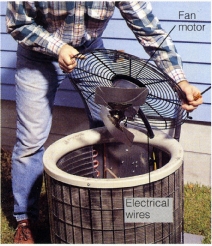 |
3. Spray fins with a garden hose from inside outward to clear any dirt. Remove debris that has collected on the bottom. Evict mice and other critters that might have moved in over the winter, then screw top back on. |
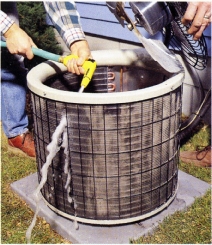 |
4. Turn power back on and adjust thermostat so unit comes on. Listen for odd noises that might indicate problems. After 10 minutes, feel the refrigerant pipes’ bare metal. Insulated pipe should feel cool and bare pipe warm. |
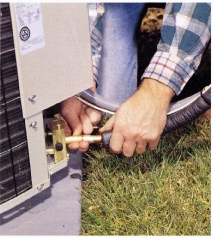 |
| 5. Open the blower compartment, with power turned off, and lubricate any accessible ports on blower motor with five drops of electric-motor oil. Vacuum any dust that has collected in the blower compartment. | 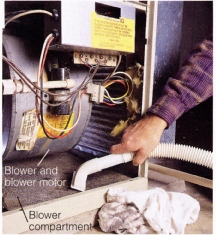 |
| 6. Check condensate drain for sludge and algae growth. To kill algae, pour 1 part bleach to 16 parts water solution through rigid tubes. Remove and clean flexible tubes. If possible, poke a wire into the drain port to clear it. | 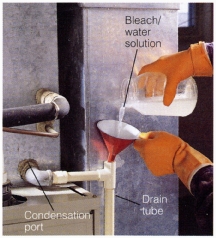 |
